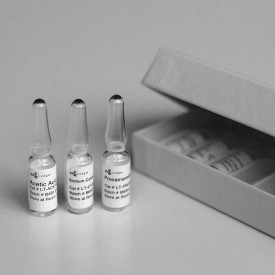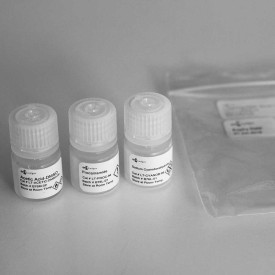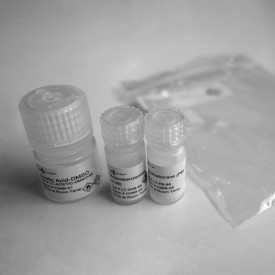Ceramide Glycanase Kit
References
[1] Jirmo AC, Rossdam C, Grychtol R, et al; Differential expression patterns of glycosphingolipids and C‐type lectin receptors on immune cells in absence of functional regulatory T cells; Immun Inflamm Dis (2020); 8: 512–522
[2] Yu-Teh L, Su-Chen L; Ceramide glycanase from Leech, Hirudo medicinalis, and earthworm, Lumbricus terrestris; Methods in Enzymology (1989); 179: 479-487
Ceramide glycanase can be used to deglycosylate a variety of glycosphingolipids by cleaving the β-glycosyl linkage. Ceramide glycanase allows the identification of glycosylation patterns of glycosphingolipids through cleaving the glycan moiety and making it accessible to LudgerTag labelling technology.
Glycosphingolipids (GSLs) are the most abundant and diverse class of glycolipids in animals (and are also present in fungi, plants, and invertebrates). Glycans present on GSLs have important roles in physiology and pathology. The ability to identify and measure GSLs is important for research in developmental neurobiology as well as lysosomal storage diseases such as Tay-Sachs and Gaucher’s disease. There is also growing interest in GSLs as possible targets for immunotherapy.
Ceramide glycanase is an enzyme used to release glycans from GSLs to enable their characterisation. It cleaves glycans including GM1, GM2 and GM3 by cleaving the β-glycosyl linkage. Glycans can then be labelled using LudgerTag labelling technology. We have purified ceramide glycanase from Hirudo medicinalis and offer this in a kit along with buffer and GM1 glycolipid substrate.
Kit includes enzyme, reaction buffer and GM1 standard. Sufficient for up to 150 reactions.
Product specification:
Ceramide glycanase is an enzyme used to release glycans from glycosphingolipids (GSLs) to enable their characterisation. It cleaves glycans including GM1, GM2 and GM3 by cleaving the β-glycosyl linkage. Glycans can then be labelled using LudgerTag labelling technology.
Product description EC 3.2.1.123 oligoglycosylglucosylceramide glycohydrolase.
Glycoside Hydrolase Family: GH5
Alternative Names: Ceramidase, Ceramide glycanase, Endoglycosylceramidase.
Application: Ceramide glycanase can be used to deglycosylate a variety of glycosphingolipids by cleaving the β-glycosyl linkage.
Specific activity Defined as the amount of enzyme required to hydrolyze 1.0 nmol of glycan from ganglioside GM1 in 1 minute at 37°C, 0.05M NaOAc, 1mg/ml TDC, 5mg/ml BSA pH 5.0. Cleavage is monitored by HPLC.
Cleavage Ceramide Glycanase cleaves sphingolipids such as GM1.
Specificity Ceramidase cleaves glycans of various substrates including:
- > 95% GM2, GM3, GD3, GD1a, GD1b.
- > 90% GM1, GT1b, CTH, LacCer.
- > 20% GlcCer.
- Not determined: GA1, GM2(Gc), GA2.
Optimum pH 4.5 – 6.5.
Quantity 7.2mg/mL as assessed by BCA UV assay
Activity 20μU/ml
5μl in a total of 20μl reaction mix will hydrolyze 1nmol of GM1 at 0.467pmols/min
Quality Control Free from α-N-acetylglucosaminidase, α-fucosidase, β-galactosidase, β-glucosidase, α- and β-mannosidases.
Formulation The enzyme is stored in a sterile filtered solution containing 0.05M NaOAc, 1mg/ml Sodium Taurodeoxycholate, 5mg/ml BSA, pH 5.0.
Suggested usage:
1. Pipette 5 µL of LZ-CER-BUFFX4 into an Eppendorf tube, followed by 5 µL of approximately 1nmol of the glycolipid sample to be tested.
2. For the positive control reaction, add 5 µL of GLIP-GM1-01 substrate to 5 µL of LZ-CER-BUFFX4 into an Eppendorf tube.
3. Add 2 µL of LZ-CER-HM-10 (the enzyme) to the reaction mixture and mix gently by tapping the Eppendorf tube with your finger. Make a total reaction mix up to 20 µL with water.
4. Incubate your samples in a water bath, oven or any other constant heating source at 37°C for 24 hrs.
The samples are now ready for procainamide, 2-AB or 2-AA labelling and subsequent analysis by HPLC.
Samples can be stored frozen at this point.
Source: Hirudo medicinalis
Molecular Weight Mw = unspecified

Contents:
- LudgerZyme Ceramide Glycanase - 1 vial of 55 µL.
- RXN buffer (4x concentrate) - 1 vial of 150 µL.
- GM1 glycolipid - 1 vial of 10 µL (approx. 2 nMol).
Number of Samples: Sufficient for up to 25 samples.
Amount of Samples: Up to 1 nmol of glycolipid.
Suitable Samples: Isolated glycolipids containing a ceramide backbone.
Storage:
-
Long-term storage - store at – 20°C - stable for at least a1 year.
Protect from sources of heat and light. Avoid multiple freeze-thaw cycles. - Short-term storage - up to 14 days - store at 4°C.
Protect from sources of heat and light.





















